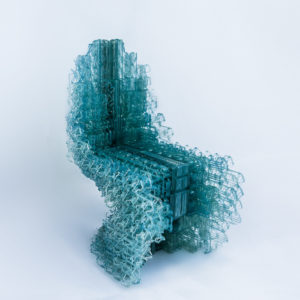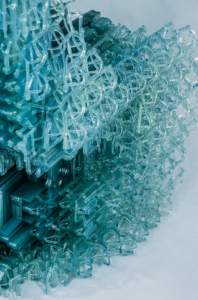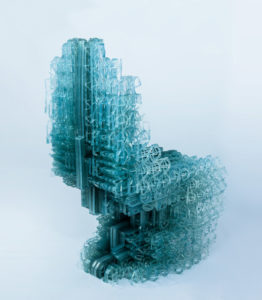DCL Researchers’ New 3D Printing Software Used to Design Voxel Chair 3D Printed with a Continuous Line of Material
 Whenever we hear about a new project from researchers and students at the Bartlett School of Architecture in London, we know it’s going to be something unique and interesting, like a self-sustaining quarry project in Rio de Janeiro that uses quarry dust as a 3D printing material, developing new methods for 3D printing with concrete, or making a robot that can 3D print intricate, curved filigree chairs. Now, a team of Bartlett researchers is back with new 3D printing software, which they used to design another robot-built chair, called the Voxel Chair v1.0. The software, created to open up even more 3D printing possibilities, was developed at Bartlett’s Design Computation Lab (DCL), which is a part of University College London.
Whenever we hear about a new project from researchers and students at the Bartlett School of Architecture in London, we know it’s going to be something unique and interesting, like a self-sustaining quarry project in Rio de Janeiro that uses quarry dust as a 3D printing material, developing new methods for 3D printing with concrete, or making a robot that can 3D print intricate, curved filigree chairs. Now, a team of Bartlett researchers is back with new 3D printing software, which they used to design another robot-built chair, called the Voxel Chair v1.0. The software, created to open up even more 3D printing possibilities, was developed at Bartlett’s Design Computation Lab (DCL), which is a part of University College London.
 The DCL is a research laboratory that develops design methods for using computational technologies in architectural design, assembly, and fabrication; current research projects include work in additive assembly and 3D printing, robotics, computational methods, modularity, and prefabrication.
The DCL is a research laboratory that develops design methods for using computational technologies in architectural design, assembly, and fabrication; current research projects include work in additive assembly and 3D printing, robotics, computational methods, modularity, and prefabrication.
According to the DCL website, “We believe architecture should be wholly digital – from the scale of the micron and particle to the brick, beam and building. This embodies a fundamental shift in architecture and design thinking that is unique to our research and projects. In our work we have demonstrated that an architecture that is digital can close gaps between the way in which we design and the way in which we fabricate and assemble objects, buildings and even infrastructure.”
 The DCL research team’s new software, which is currently still in development, uses a continuous line of material to create designs, as opposed to the more typical layer-by-layer approach of conventional 3D printing methods. In the case of the prototype Voxel Chair v1.0, the researchers used transparent blue-tinted PLA to test the new software. The robot manufactures the designs by extruding melted plastic directly into the air. The plastic then sets as it cools.
The DCL research team’s new software, which is currently still in development, uses a continuous line of material to create designs, as opposed to the more typical layer-by-layer approach of conventional 3D printing methods. In the case of the prototype Voxel Chair v1.0, the researchers used transparent blue-tinted PLA to test the new software. The robot manufactures the designs by extruding melted plastic directly into the air. The plastic then sets as it cools.
The design team is led by DCL’s two co-directors, Manuel Jiménez Garcia and Gilles Retsin; other team members include Vicente Soler, Ignacio Viguera Ochoa, and Miguel Angel Jimenez Garcia, with fabrication support by Soler and Nagami Design.
Just like Bartlett’s CurVoxels filigree chairs, the Voxel Chair v1.0 was modeled after Danish designer Verner Panton’s iconic, S-shaped Panton chair, designed in the early 1900s. The shape has a complex cantilever geometry, and is immediately recognizable. After the CurVoxels chair project, DCL set out to create software that would allow them to generalize the Panton chair design approach and test out various versions of the chair, while enabling others to mimic the process. As opposed to the original solid plastic Panton chair, DCL’s Voxel Chair v1.0 is actually a web of hollows, which was made by a continuous 2.36 km line of robot-extruded plastic.
“This may look like a Panton chair, but it’s actually completely different. The Panton chair was a pure surface, optimised to mould. This chair is the opposite: a cloud-like volume, optimised for robotic extrusion,” explained Retsin and Jiménez Garcia.
 In addition to allowing intricate patterns to be designed, the DCL software enables designers to develop more efficient, lightweight forms without using unnecessary material. It can also be used to design large-scale metamaterials, like with the Hasso Plattner Institute all-plastic door latch; metamaterials have a unique internal structure that’s specifically engineered for certain behaviors.
In addition to allowing intricate patterns to be designed, the DCL software enables designers to develop more efficient, lightweight forms without using unnecessary material. It can also be used to design large-scale metamaterials, like with the Hasso Plattner Institute all-plastic door latch; metamaterials have a unique internal structure that’s specifically engineered for certain behaviors.
Retsin and Jiménez Garcia said, “This approach is not only more functional in terms of performance, but it also offers designers opportunities to really work directly with incredible amounts of data. Instead of designing the form of the chair, you design the behaviours and properties of the material directly.”
 The Voxel Chair v1.0, currently on exhibit at the Centre Pompidou Paris, is obviously named after voxels, which act like pixels in three-dimensional space, and have been used often in video games and medical imaging. The software itself is based on voxels, so designers have more control over the 3D printing process by designing the interior of an object as well as its surface as voxel-level control offers more complex design capabilities. Users can directly manipulate the tool paths, or layers, with DCL’s software, as opposed to using modeling software that will automatically slice an object into tool paths.
The Voxel Chair v1.0, currently on exhibit at the Centre Pompidou Paris, is obviously named after voxels, which act like pixels in three-dimensional space, and have been used often in video games and medical imaging. The software itself is based on voxels, so designers have more control over the 3D printing process by designing the interior of an object as well as its surface as voxel-level control offers more complex design capabilities. Users can directly manipulate the tool paths, or layers, with DCL’s software, as opposed to using modeling software that will automatically slice an object into tool paths.
“As designers we can’t usually control these or use these tool paths themselves as a medium to design with – its a very top-down process. Our software allows designers to bypass this, and immediately design with the tool paths themselves – which gives you access to much more detail and control,” explained Retsin and Jiménez Garcia.
The DCL team’s software was the recipient of the 2016 Autodesk ACADIA Emerging Research Award for best paper, and will be presented this November at the 2017 ACADIA conference, held at MIT. To help reduce cost, and make the 3D printing process viable for industrial purposes, the team also developed a new extruder for the robot, which directly melts raw plastic pellets instead of using filament. Discuss in the Voxel Chair forum at 3DPB.com.
[Source: Dezeen / Images: DCL]
Subscribe to Our Email Newsletter
Stay up-to-date on all the latest news from the 3D printing industry and receive information and offers from third party vendors.
You May Also Like
3D Printing Unpeeled: Wind Turbines, Probiotics and Lenses
TPI Composites, ORNL and Ingersoll Rand are working to make wind turbine tooling segments that can be 18.3 meters long. These elements also include resistive wires that help keep the...
3D Printing Unpeeled: Digital FDM Filament for Functional Gradients
Just published in Nature, a paper by a Seoul National University team looks at “3D printing with a 3D printed digital material filament for programming functional gradients.” Sang-Joon Ahn, Howon...
3D Printing Unpeeled: $5000 Cold Spray 3D Printer, Roland DGA & Living Materials
The AeroForge is a $5000 cold spray metal printer for copper made by a student team at Rice University. In a paper for ACS Central Science a team from Nanjing...
3D Printing Webinar and Event Roundup: April 28, 2024
In this week’s 3D Printing Webinar and Event Roundup, the Ceramics Expo is taking place in Michigan, Stratasys continues its advanced training courses, and SPE is holding a Polymer Characterization...


































